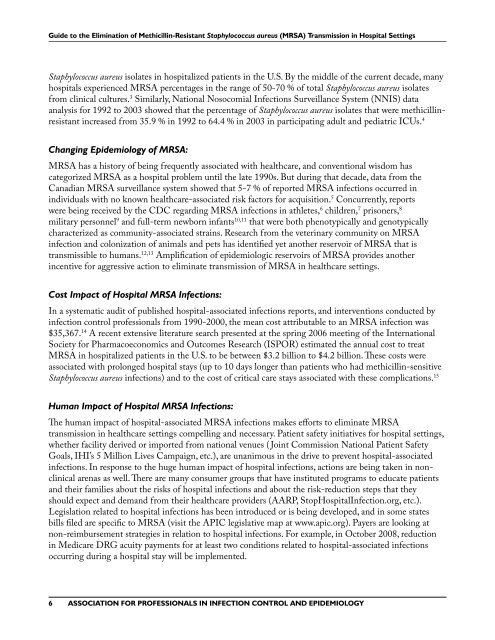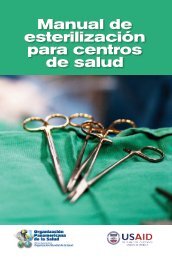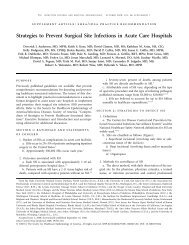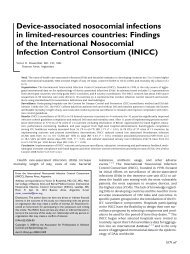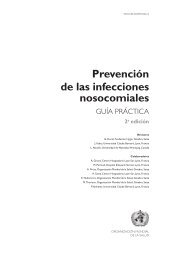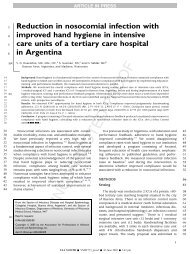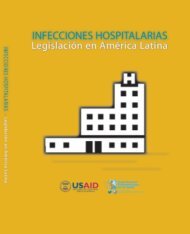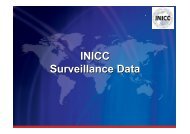APIC MRSA Elimination Guideline
APIC MRSA Elimination Guideline
APIC MRSA Elimination Guideline
You also want an ePaper? Increase the reach of your titles
YUMPU automatically turns print PDFs into web optimized ePapers that Google loves.
Guide to the <strong>Elimination</strong> of Methicillin-Resistant Staphylococcus aureus (<strong>MRSA</strong>) Transmission in Hospital SettingsStaphylococcus aureus isolates in hospitalized patients in the U.S. By the middle of the current decade, manyhospitals experienced <strong>MRSA</strong> percentages in the range of 50-70 % of total Staphylococcus aureus isolatesfrom clinical cultures. 3 Similarly, National Nosocomial Infections Surveillance System (NNIS) dataanalysis for 1992 to 2003 showed that the percentage of Staphylococcus aureus isolates that were methicillinresistantincreased from 35.9 % in 1992 to 64.4 % in 2003 in participating adult and pediatric ICUs. 4Changing Epidemiology of <strong>MRSA</strong>:<strong>MRSA</strong> has a history of being frequently associated with healthcare, and conventional wisdom hascategorized <strong>MRSA</strong> as a hospital problem until the late 1990s. But during that decade, data from theCanadian <strong>MRSA</strong> surveillance system showed that 5-7 % of reported <strong>MRSA</strong> infections occurred inindividuals with no known healthcare-associated risk factors for acquisition. 5 Concurrently, reportswere being received by the CDC regarding <strong>MRSA</strong> infections in athletes, 6 children, 7 prisoners, 8military personnel 9 and full-term newborn infants 10,11 that were both phenotypically and genotypicallycharacterized as community-associated strains. Research from the veterinary community on <strong>MRSA</strong>infection and colonization of animals and pets has identified yet another reservoir of <strong>MRSA</strong> that istransmissible to humans. 12,13 Amplification of epidemiologic reservoirs of <strong>MRSA</strong> provides anotherincentive for aggressive action to eliminate transmission of <strong>MRSA</strong> in healthcare settings.Cost Impact of Hospital <strong>MRSA</strong> Infections:In a systematic audit of published hospital-associated infections reports, and interventions conducted byinfection control professionals from 1990-2000, the mean cost attributable to an <strong>MRSA</strong> infection was$35,367. 14 A recent extensive literature search presented at the spring 2006 meeting of the InternationalSociety for Pharmacoeconomics and Outcomes Research (ISPOR) estimated the annual cost to treat<strong>MRSA</strong> in hospitalized patients in the U.S. to be between $3.2 billion to $4.2 billion. These costs wereassociated with prolonged hospital stays (up to 10 days longer than patients who had methicillin-sensitiveStaphylococcus aureus infections) and to the cost of critical care stays associated with these complications. 15Human Impact of Hospital <strong>MRSA</strong> Infections:The human impact of hospital-associated <strong>MRSA</strong> infections makes efforts to eliminate <strong>MRSA</strong>transmission in healthcare settings compelling and necessary. Patient safety initiatives for hospital settings,whether facility derived or imported from national venues ( Joint Commission National Patient SafetyGoals, IHI’s 5 Million Lives Campaign, etc.), are unanimous in the drive to prevent hospital-associatedinfections. In response to the huge human impact of hospital infections, actions are being taken in nonclinicalarenas as well. There are many consumer groups that have instituted programs to educate patientsand their families about the risks of hospital infections and about the risk-reduction steps that theyshould expect and demand from their healthcare providers (AARP, StopHospitalInfection.org, etc.).Legislation related to hospital infections has been introduced or is being developed, and in some statesbills filed are specific to <strong>MRSA</strong> (visit the <strong>APIC</strong> legislative map at www.apic.org). Payers are looking atnon-reimbursement strategies in relation to hospital infections. For example, in October 2008, reductionin Medicare DRG acuity payments for at least two conditions related to hospital-associated infectionsoccurring during a hospital stay will be implemented.ASSOCIATION FOR PROFESSIONALS IN INFECTION CONTROL AND EPIDEMIOLOGY


